Six Flags over Texas’ aptly-named Titan roller coaster turned 20 years old in 2021, the park’s 60th anniversary season. Let’s take a look back all the way to 2001 when the park constructed and introduced its biggest and most expensive attraction, ever.
A Goliath Predecessor
It all started on the West Coast in 1999 when orange track and teal support pieces started mysteriously arriving at Six Flags Magic Mountain. Coaster enthusiasts immediately began trading rumors for what the new California ride would be, potentially pointing to a name of Mutiny.
Eventually SFMM announced Goliath, a 235 ft tall hypercoaster manufactured by Giovanola. Stat-wise, the coaster featured a 61° first drop, speeds of 85 mph, and 4,500 feet of track.
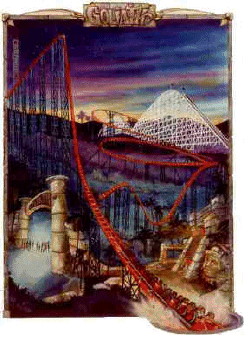
Early rendering of Goliath at Six Flags Magic Mountain, Titan’s sister ride
Goliath opened to the general public February 11th, 2000 to rave reviews for its high speeds, smooth trackwork, and unique combination of airtime and strong positive G’s.
Everyone started wondering if and when the amusement world would see another ride from this relative newcomer Giovanola, who certainly went big for its second-ever roller coaster.
Six Flags over Texas’ 40th
Meanwhile back at the original Six Flags park, rumors started forming for SFoT to also get something big in 2001. After all, it was the park’s 40th anniversary. Many of the rumors were predicting a hypercoaster addition, with some even specifically mentioning a Superman: Ride of Steel clone.
As it turned out, they were wrong about the ride, but right in principle.
Preparation Begins
As is often the case, land prep for the new ride began long before the park made any announcements. Contractors placed construction flags throughout the employee softball field and fenced off the northern parts of the employee parking lot around September 2000. Initial land preparation followed shortly after.
-
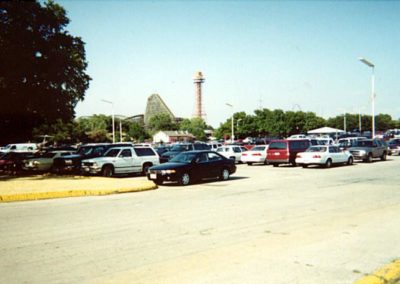
An early view of the employee parking lot before Titan construction began
-
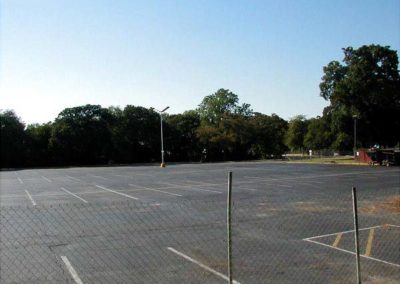
Sections of the employee parking lot fenced off
-

Trees either marked for removal or for keeping (reportedly an Angus Wynne directive for certain trees)
-
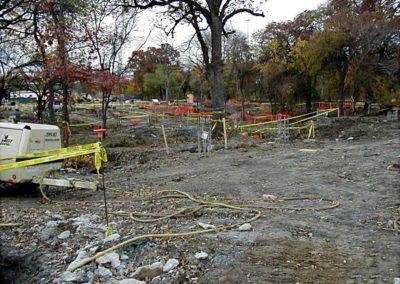
Early land preparation (circa 2000)
-
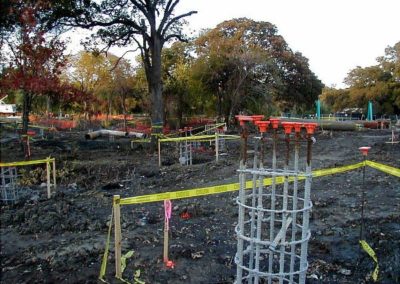
Footers being prepared for Titan's second half
-
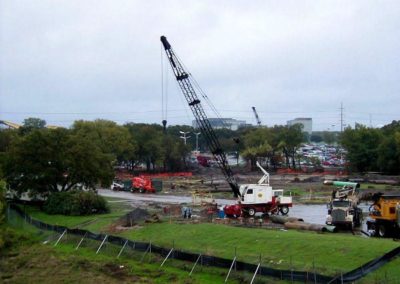
Workers prepare the land for the turnaround's footers
Crews also filled the old, long-unused employee swimming pool where Titan’s queue would later be placed. Both the employee softball field and pool can be spotted in the aerial comparison below.
Aerial view of Titan under construction in 2001 and a comparison from 1995 showing the softball field it replaced
Titan Goes Vertical
Fan websites closely followed the progression of the new ride while the park kept mum. Six Flags utilized the massive overflow parking lot as a staging area for track and support pieces once they arrived overseas from Switzerland.
-
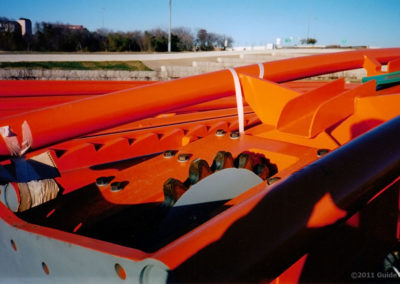
Photo from December 2000 showing the crest of Titan's lift hill track piece in the parking lot.
-
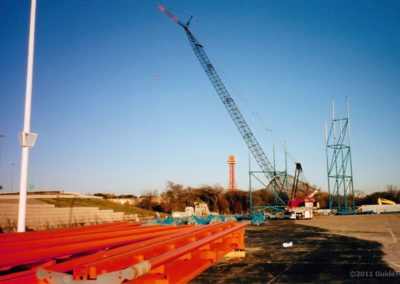
Titan under construction, taken December 16, 2000
-

These supports likely went on the turn between the station and lift
-

The base piece of the lift hill sitting in the parking lot
In November 2000, Titan went vertical with the first parts installed being supports for the turnaround and the smaller supports between the brake run and lift hill.
-
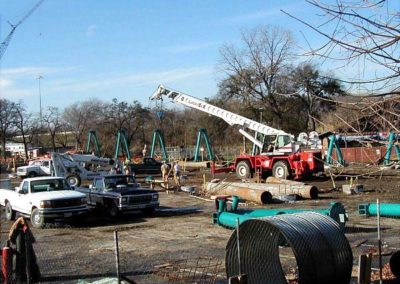
Supports for the final brake run into the station
-
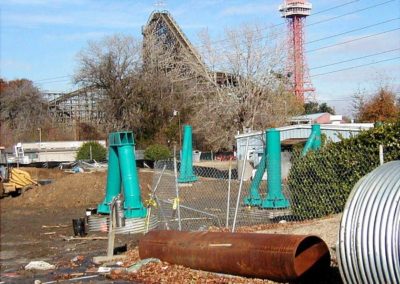
Supports for the first turn between the station and lift
-

Turnaround construction as seen from across Johnson Creek
-
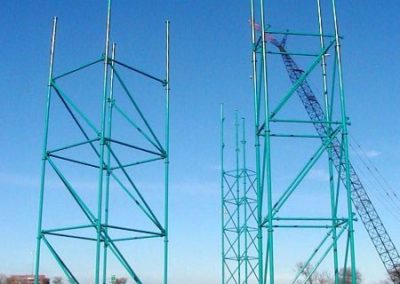
Turnaround supports go vertical as seen from the overflow lot
The Announcement
Finally on November 14, 2000, Six Flags over Texas officially announced Titan would be their newest coaster and kick off the park’s Texas-sized 40th season. The new ride would stand over 100 feet taller than the Texas Giant, creating a new park landscape that would be visible miles away.
Though official numbers were never released, estimates tagged the ride at $25 million making it the largest and most expensive ride Six Flags had ever produced.
While some disappointment settled over coaster enthusiasts when they learned Titan would be a near-clone of Goliath, at least one feature would set it apart from its California counterpart: an additional 540° helix before the mid-course brake run. The extra element extends Titan’s track length to 5,312 ft.
Snow Day
One wintry Arlington day allowed the rare sight of Titan’s construction site dusted with snow.
Construction Continues into 2001
Construction continued through the new year and into early 2001 with contractors installing track on the lift hill and turnaround.
-
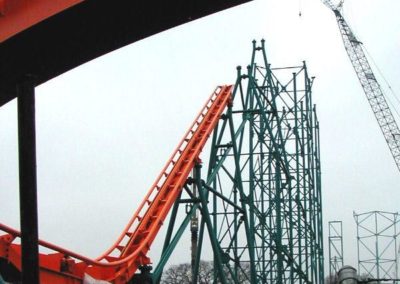
View of lift hill from beneath station turnaround
-
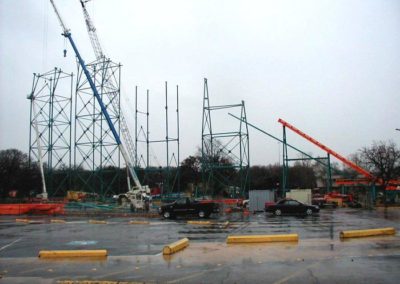
Early lift hill track installation
-

Track is installed on Titan's massive turnaround
-
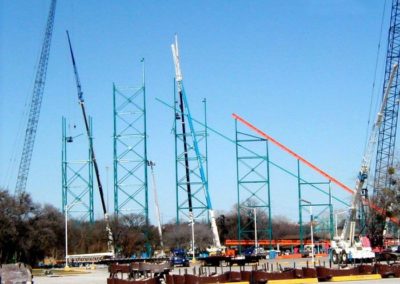
More track and chain return trough is installed
-

Supports for the overbanked turn after the mid-course brakes
-
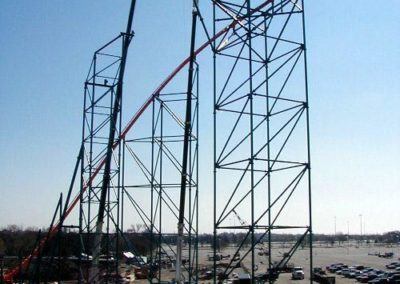
More track is placed on the turnaround
Lift Topping-Off and Helix Progress
Once Titan’s lift hill was topped off, ironworkers placed a Christmas tree at its highest point in keeping with tradition. The coaster’s differentiating element, its first helix, also made rapid progress.
-

The completed lift is topped out with a Christmas tree, as is tradition with ironworking
-
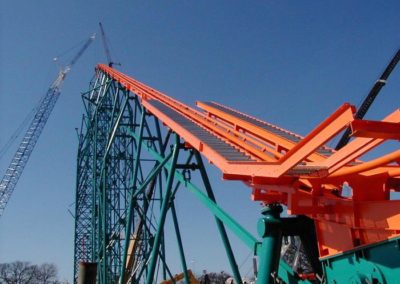
Stairs are installed up the length of the lift
-
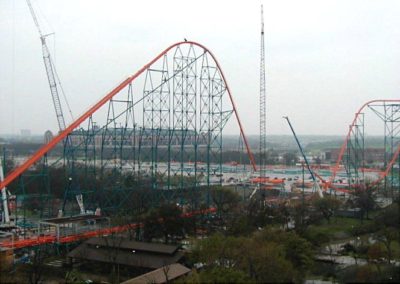
The parking lot in the background full of support and track pieces shows much work was left to do
-
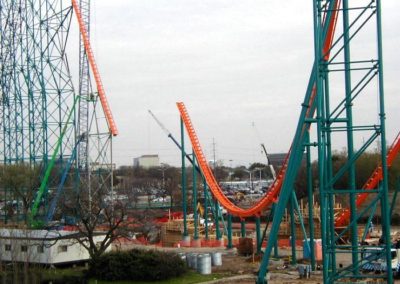
Concrete forms are built to create the tunnel
-
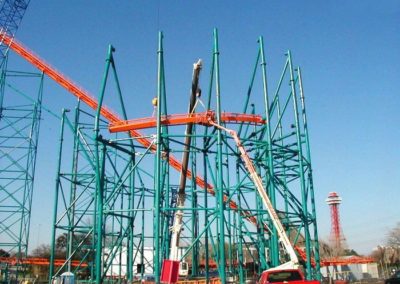
First track pieces being installed in the helix element
-
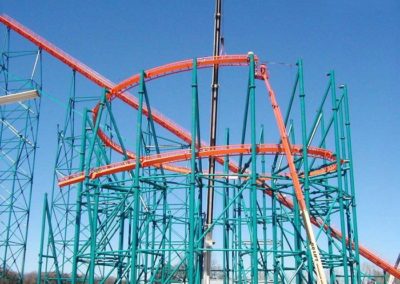
The helix rounds toward completion
Station Work and Final Preparations
While crews completed track work elsewhere, the station quickly formed, along with the electrical/computer room and elevator rooms beneath the station that house Titan’s PLCs and hydraulic system for the station’s elevator.
-
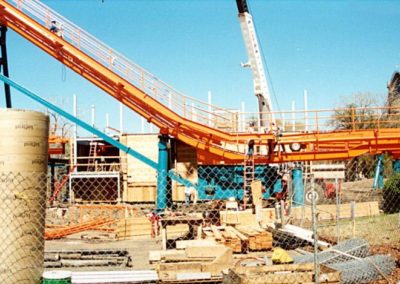
Early station work
-
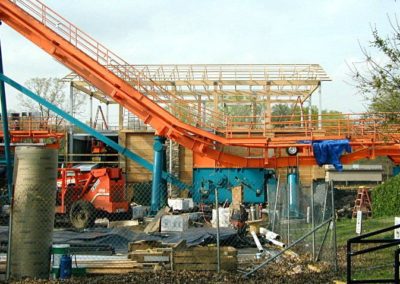
Titan's station framing goes up
-
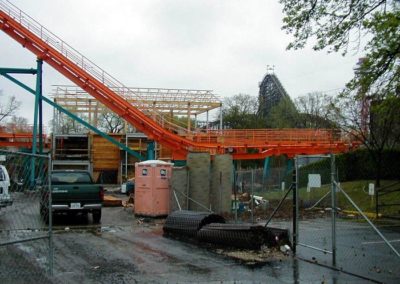
View of station progress and turn into lift hill
-
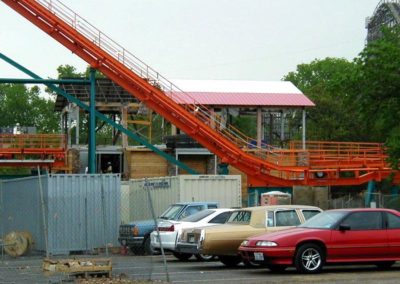
Station nearing completion with the Texas flag roof
-
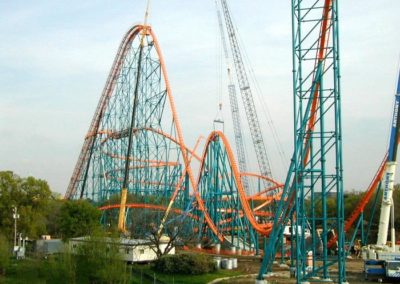
A mostly-complete Titan showing off the tunnel's structure before it was covered
-
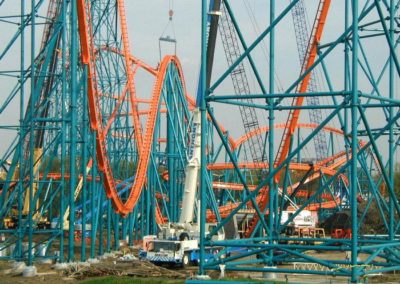
Final track pieces being installed
-
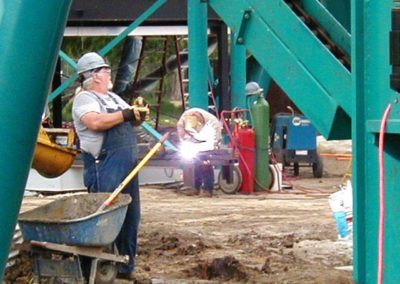
Contractors welding near the transfer track
-
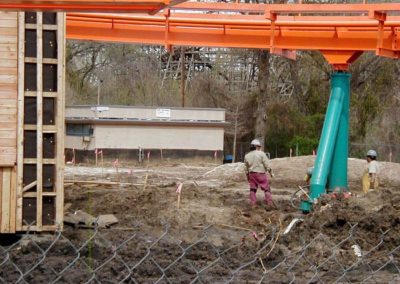
Titan's queue area was formerly the employee swimming pool
Titan’s three trains also arrived from Giovanola, colored yellow, orange, and red. The trains have 5 cars, each seating 6 for a total capacity of 30 passengers.
Testing Time
Titan’s final track piece was installed in late February. The ride was reportedly scheduled to open at the beginning of the season in March, but a rainy winter delayed construction several times.
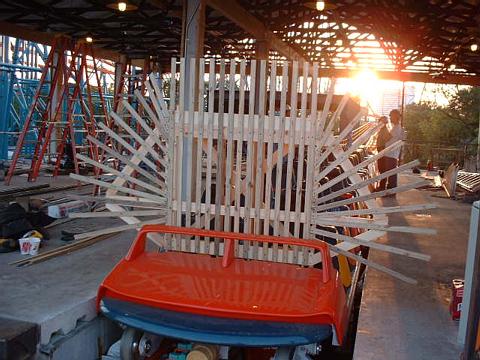
This peculiar-looking device was for the clearance test, ensuring riders’ hands wouldn’t smack any supports or other objects.
Media Day
Six Flags over Texas held its media day on April 26, 2001, inviting news and radio stations, VIPs, and ACE to ensure no seat went empty on any train. The gargantuan new ride was heavily covered by local media with some of the first riders being radio station contest winners.
-
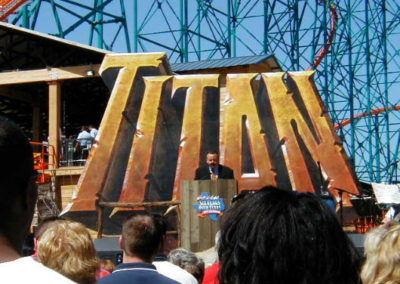
Six Flags president Gary Story speaks at Media Day
-
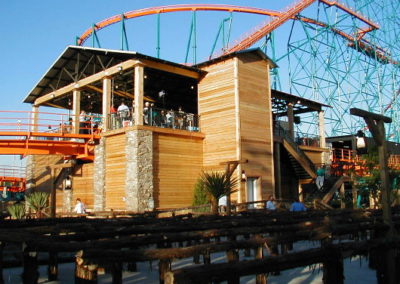
Titan's queue was originally uncovered and merciless during the summer
Titan officially opened to the general public the following day, April 27, 2001.
Uncommon Angles
These are some of the more rare angles from which Titan has been photographed.
-
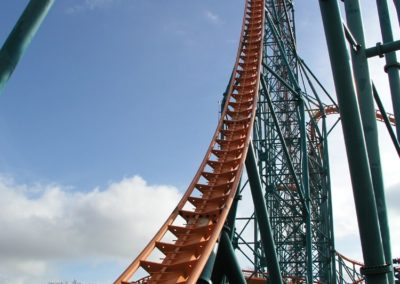
Titan's massive first drop as seen from the bottom
-

A view down Titan's just-completed first drop
-
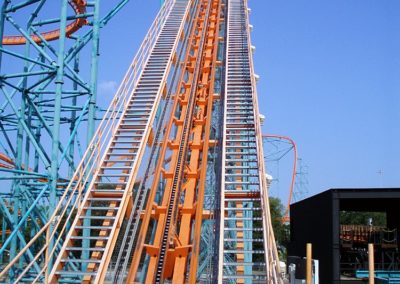
Titan's long lift hill
-
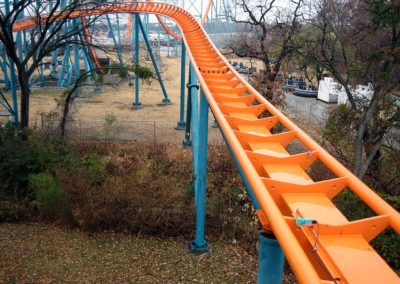
Titan's final turn goes over the employee driveway and into the brake run
-
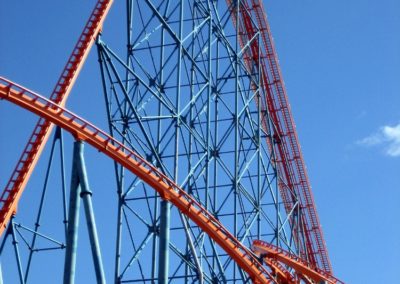
Titan really stands out when its bright orange and teal paint hasn't been UV-faded
Titan vs. Goliath Comparison
Check out our side-by-side comparison of Titan and Goliath POVs to see how similar (and different) the two rides are.
Titan Today
True to its name, Titan was a monumental undertaking for Six Flags over Texas. Not only was it the largest and most expensive investment ever at the park, but it helped round out the park’s coaster lineup which lacked a large-scale steel ride.
Even 20 years later, Titan remains the tallest and fastest roller coaster in Texas (and still the 8th tallest and fastest in the country).
Titan also proved that an essentially land-locked park built to its perimeter could still find new territory to expand into and gives park enthusiasts hope that it won’t be the last big new coaster to grace the park.
-
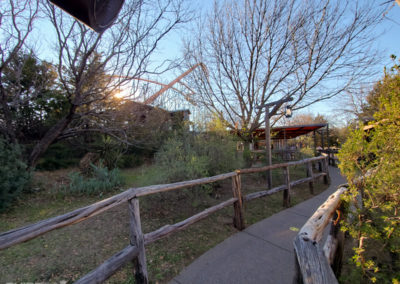
Once barren and desert-like, the native Texas foliage around Titan's queue has filled in nicely over the years
-
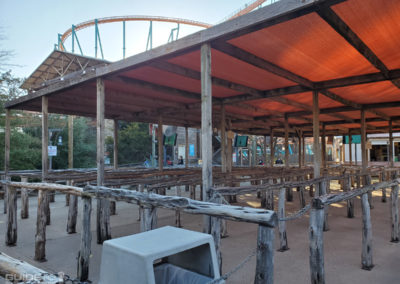
Titan's queue line in 2021, thankfully still covered
One thing we know for certain is that the world won’t be seeing any more Giovanola coasters. The company filed for bankruptcy protection shortly after Titan was completed and eventually ceased operation in 2004 after 116 years. Titan was their third and final roller coaster, so one can confidently assume there won’t be any further Goliath/Titan clones.
Random Titan Facts
- When Titan first opened, trains would fly through its midcourse brake run with little-to-no braking. Eventually the park began applying heavy braking to slow the train down during the second half of the ride, mainly to lessen the intensity of the helix which infamously made many riders grayout or even temporarily blackout.
- A combination of high speeds and hot summer temperatures would occasionally result in the wheel’s polymer treads melting and delaminating them from the steel core. Though not a safety risk, it would cause the trains to run much louder than usual. The park added water misters on the brake run to cool the wheels after each cycle before apparently finding a better formulated wheel material.
- Due to their similarities, Titan and Goliath are often interchanged on Six Flags’ merchandise, with images often being of Goliath since it came first.
Titan Info-Video
Our off-ride video below features great visuals and info about the Titan roller coaster.
Feature Credits
- Special thanks to Jeremy Ross for use of his many Titan construction images
- Aerial before/after courtesy US Geological Survey



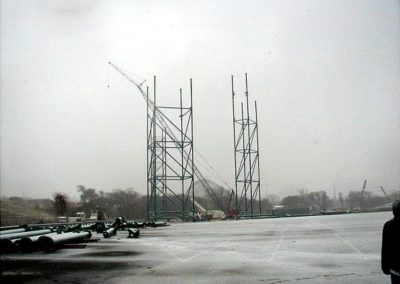
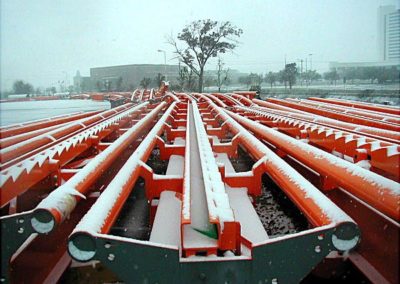

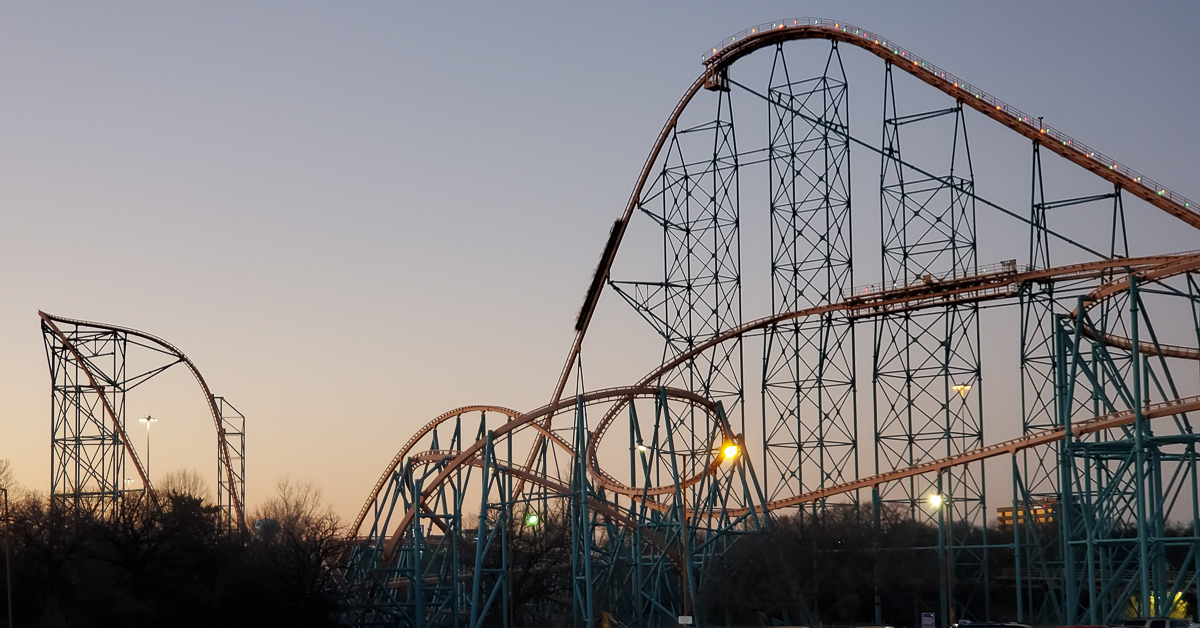
Recent Comments